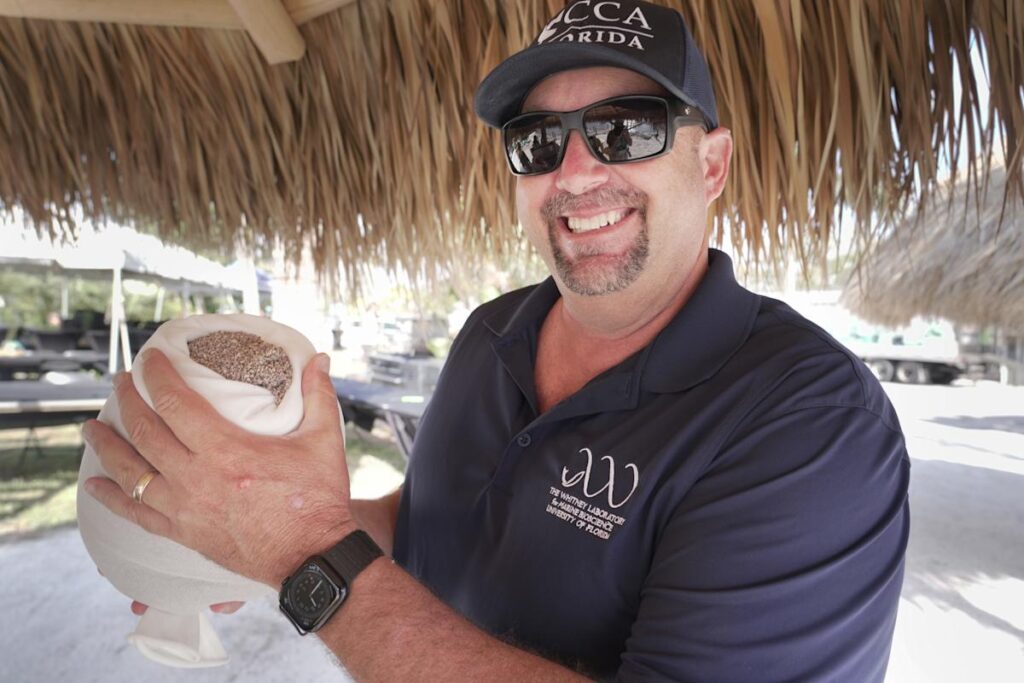Can a few good drones and a billion “super clams” save the Indian River Lagoon?
Maybe not all by themselves, but these shellfish ways are well worth a try, according to the Indian River Lagoon Billion Clam Initiative, spearheaded by the Coastal Conservation Association Florida, a nonprofit sportfishing and marine advocacy group.
A drone hovered above the lagoon in Grant-Valkaria Friday to spread ‘super-clam cluster bombs’ in hopes to seed a once natural defense mechanism long lost from a lagoon that’s been under ecological assault for decades.
Friday’s drone-clam deployment was part of ongoing Earth Day-themed efforts by CCA, Duke Energy Florida, marine-products company Star brite and other conservation partners. It was a kickoff event to a weekend-long Clean Water Collective, a community conservation event. In total, they plan to deploy 4 million clams throughout the weekend.
The effort continues the so-called Billion Clam Initiative, a large-scale effort led by CCA Florida in partnership with the University of Florida Whitney Laboratory and Capt. Blair Wiggins. The project, which began in 2017, uses state-of-the-art technology to deploy clams in effort to improve water quality and restore ecological balance throughout the lagoon. To date, the initiative — with the hovering help of clam-dumping drones — has put 49 million clams in the lagoon.
Last year, CCA joined scientists at Hog Point, south of Melbourne Beach, to spread 3 million clams in the lagoon.
For every $1 donated to the initiative, 100 clams are released in the lagoon. To help kick start the initiative, CCA Florida and the Duke Energy Mariculture Center donated $100,000 in October 2023.
Drones soar above clam-planting by hand
Clams are filter feeders that remove algae and excess nutrients from coastal waters. They can also help to blunt waves, lessening shoreline erosion.
Whatever genes it takes to survive our collective waste, these clams seem to have the right stuff. They are, in the words of one researcher, “super clams.”
Survival of the fittest shellfish
These clams would make Darwin proud. University of Florida researchers began to put the earliest batches of super clams in the lagoon at River Rocks restaurant off U.S. 1 in 2020.
Todd Osborne, a biochemist at UF, had searched far and wide in the lagoon for clams with the genetic “right stuff” to survive the estuary’s harsher conditions — made harsher by decades of overfertilizing, leaky septic tanks, sewer systems and stormwater runoff.
He searched throughout the 156-mile-long lagoon for any clams that survived the recent years of severe algal blooms until finally striking shellfish gold several years ago: one pocket of crazy-tough clams in southern Mosquito Lagoon, where he harvested 39 palm-sized clams. They were about eight years old. A clam typically lives about 15 years
According to some scientists, these bivalve superheroes could be a key to helping restore the lagoon and help solve the problem of one of Florida’s worst man-made environmental messes.
Our sewage, fertilizer and runoff fuels algae for clams and oysters to feed on, and despite dips in the lagoon’s salt and oxygen levels and thick mats of seafoam, the baby clams transplanted from the hardy lineages in Mosquito Lagoon to a lab, then back to less healthy parts of the lagoon, are providing glimmers of hope that the “super clams” could join an army of other filter feeders to help cleanse the ailing estuary.
Most local clammers stopped making a decent living in the lagoon more than three decades ago. Theories vary as to why. Some blamed the economy, others state rules that were too expensive to follow and/or all the new homes, roads and resulting runoff. But researchers point more to prolonged periods of extremes: droughts or periods when heavy rains dumping too much fresh water into the lagoon for too long.
Waymer covers the environment. Reach him at (321) 261-5903 or [email protected]. Follow him on X at @JWayEnviro.
This article originally appeared on Florida Today: Drones seed clams in Indian River Lagoon
Read the full article here


